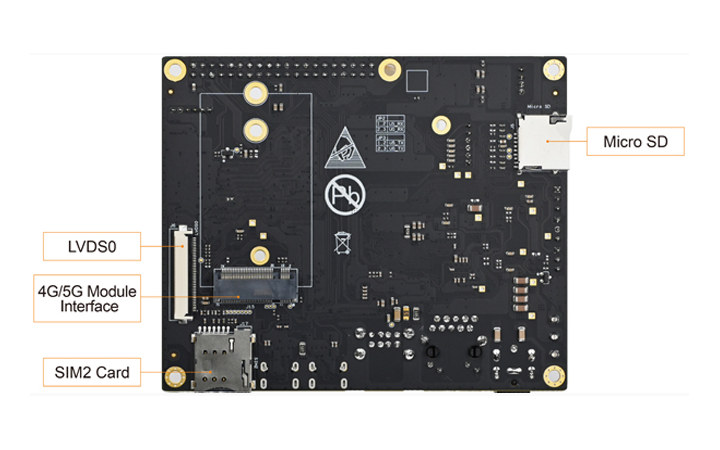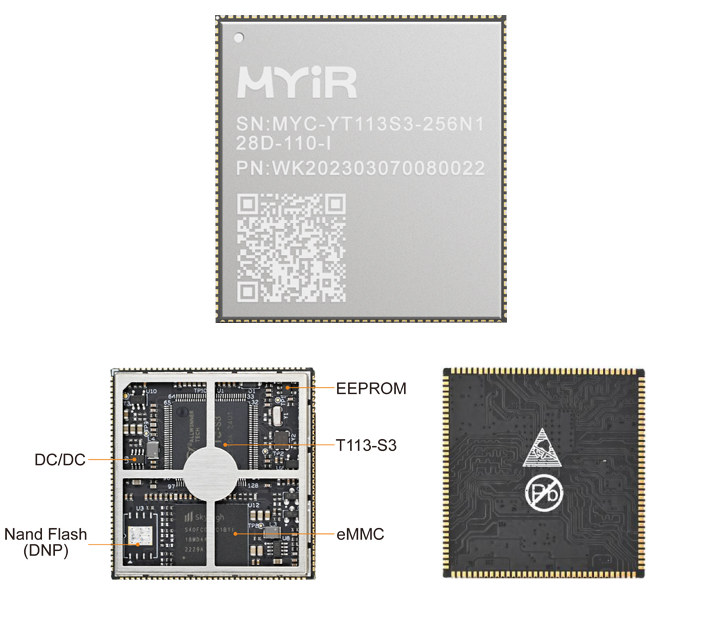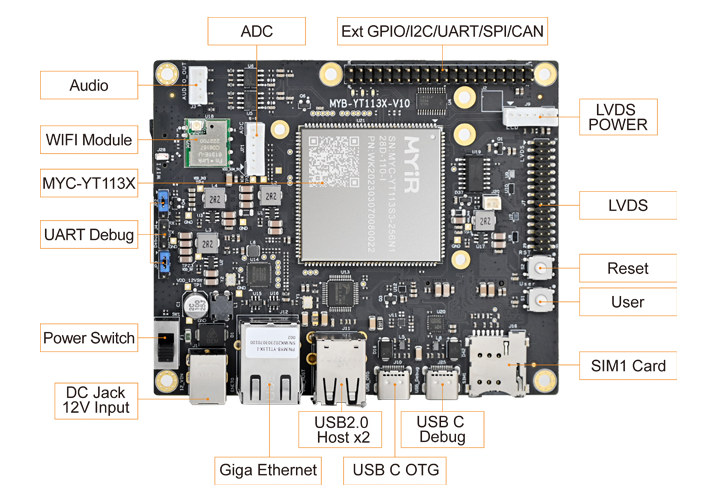MYiR MYC-YT113X is a low-cost solderable CPU module powered by an Allwinner T113-S3 dual-core Cortex-A7 processor with 128MB on-chip DDR3 RAM, and fitted with either a 256MB NAND flash or a 4GB eMMC flash for storage.
The industrial temperature grade module provides a lower-end alternative to the company’s earlier MYC-YT507H Allwinner T507-H Cortex-A53 CPU module, and offers various display, camera, audio, Ethernet, USB, and low-speed I/Os through a 140-pin stamp hole design. It is designed for HMI, industrial automation, as well as display and control terminals.
MYiR MYC-YT113X specifications:
- SoC – Allwinner T113-S3
- CPU – Dual-core Arm Cortex-A7 @ 1.2 GHz with 32 KB L1 I-cache + 32 KB L1 D-cache per core, and 256 KB L2 cache
- DSP – Single-core HiFi4
- VPU – H.265/H.264 video decoding up to 1080p60 and JPEG/MJPEG video encoding up to 1080p60
- Memory – 128 MB DDR3
- Storage – 4GB eMMC or 256MB NAND flash, 32KB EEPROM
- 1.0mm pitch 140-pin stamp hole expansion interface
- Display I/F
- 1x MIPI DSI
- 1x RGB
- 1x single-channel LVDS and 1x dual-channel LVDS or 24-bit RGB (supports up to 1080p60)
- Camera I/F – 1x Parallel CSI
- Audio – 2x I2S
- Ethernet – 1x RGMII/RMII
- USB – 2x USB2.0
- Analog – 1x GPADC and 4x TRADC
- Low-speed I/Os – 6x UART, 2x CAN, 4x TWI/I2C, 2x SPI, up to 59 GPIOs
- Display I/F
- Power supply – 5V/1A
- Dimensions – 39 x 37mm (6-layer PCB design)
- Temperature Range – -40 to 85 Celsius (industrial grade)
MYiR also designed the MYD-YT113X development board to evaluate the MYC-YT113X Allwinner T113-S3 CPU module with the following specifications:
- System-on-module – MYC-YT113X CPU module described above
- Storage – MicroSD card slot
- Video Output
- Single-channel LVDS display interface (LVDS0, 40-pin 0.5mm pitch FPC connector) for MYIR’s MY-LVDS070C LCD module with a capacitive touchscreen
- Dual-channel LVDS display interface (LVDS, 30-pin 2.0mm pitch header connector)
- Audio – 4-pin audio output connector
- Networking
- Gigabit Ethernet RJ45 port
- USB-based WiFi module
- Optional 4G LTE/5G module via M.2 socket (USB) and two SIM card slots.
- USB
- 2x USB 2.0 host ports
- 1x USB 2.0 OTG Type-C port
- Serial ports – 1x Debug UART (TTL), 4x TTL serial ports
- Expansion – 40-pin Raspberry Pi-compatible GPIO header with TWI, UART, etc.. and supporting MYIR’s MY-WIREDCOM RPI module to add CAN and RS232 interfaces
- Misc – Power Switch, Reset button, user-programmable button
- Power Supply – 12V/2A via DC jack
- Dimensions – 110 x 90mm (4-layer PCB)
- Temperature Range – -40 to 85 Celsius, but note the WiFi module is limited to -20 to 70 Celsius

MYiR provides a Linux BSP with kernel version 5.4.61, U-boot 2018.05, and the drivers for all peripherals, along with source code, and two root file systems, one minimal, one with a GUI. None of those is released publicly, so only customers would have access to it. There’s however some public code for other Allwinner T113-S3 hardware platforms, as we previously covered MangoPi MQ-Dual board and the 100ASK-T113-Pro development board, and its associated T113-S3 Core Lite CPU module.
The MYC-YT113S3-256N128D-110-I CPU module (256 NAND flash) is sold for $14, while the MYC-YT113S3-4E128D-110-I system-on-module with 4GB eMMC flash is offered for $17, while the respective development kits with all accessories (power supply, cables …) for $55 and $59. The optional MY-WIREDCOM for CAN Bus and RS485 adds $25, and the 7-inch touchscreen display is sold for $99. You’ll find the full details and purchase links on the product page.

Jean-Luc started CNX Software in 2010 as a part-time endeavor, before quitting his job as a software engineering manager, and starting to write daily news, and reviews full time later in 2011.
Support CNX Software! Donate via cryptocurrencies, become a Patron on Patreon, or purchase goods on Amazon or Aliexpress







Only 256MB NAND – what type it is? Is it SLC Single-level cell?
This would be the 3rd – after Next Thing Co C.H.I.P and Nintendo (Super) NES Classic Edition
Well, as the footprint says, it should be SPI NAND instead of raw NAND, and as I know SPI NAND should be all SLC.
Aren’t there cheaper A7 boards?
Cheaper boards? You mean the devkit? The sip itself is quite cost-effective, being dual core with a vpu and dsp and simple to integrate
I was thinking more about the SIP, there are some like, which cost $3 or so per unit at scale. It’s not a 1:1 obviously, and there isn’t the module, but the rest of the module shouldn’t be too expensive. And while it’s inferior to it in some aspects, it’s also better in others(e.g. you can get a GPU with it, which might be important for anything with a display).
STMicro introduces cost-optimized STM32MP13 Cortex-A7 microprocessor – CNX Software (cnx-software.com)
Well, but the link you posted relates to a SoC only, you need to add PCB, dc/dc converter, nand flash, eMMC and a metal shield. For me 14$ is pretty damn effective, if you could find a similar solution for 20$ with STM MP1 SoC I would be very interested.